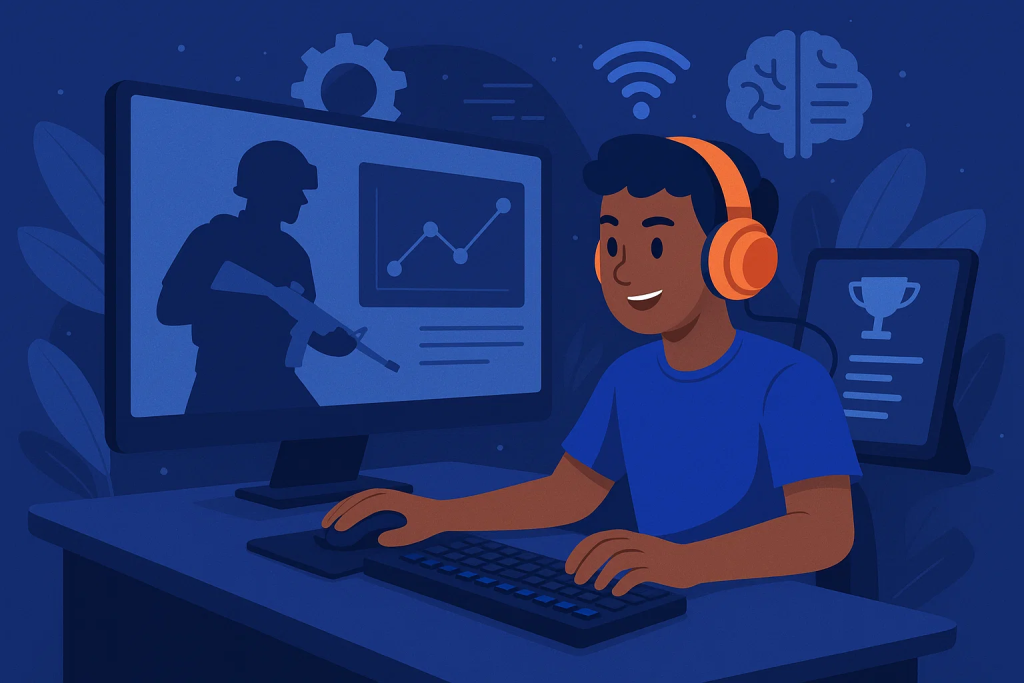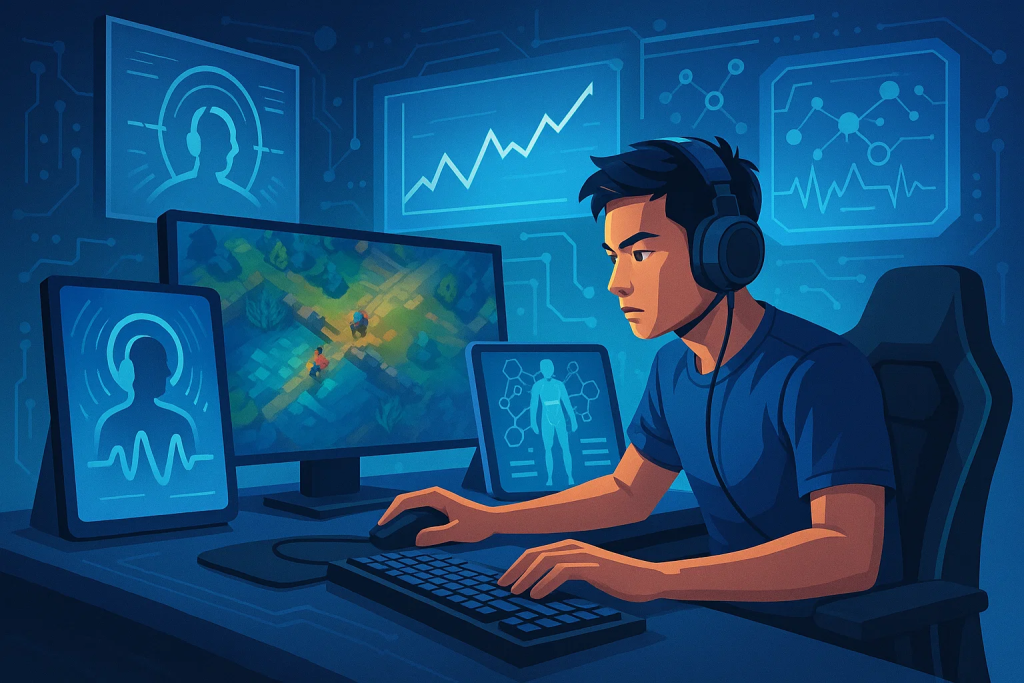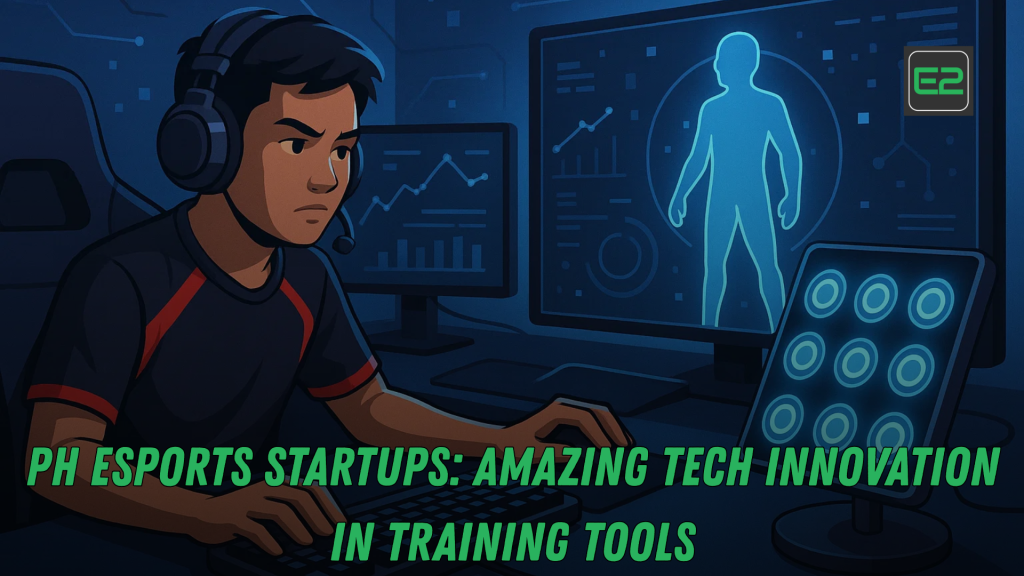Table of Contents
TL;DR
- The Philippines is a breakout esports market with tens of millions of gamers and rising prize earnings—fertile ground for training-tech startups.
- Local players to know: KALARO (PH’s first esports “super app” with tournament ops, community, monetization), AcadArena (campus esports infrastructure and training pipeline), and Mineski Global (platforms that professionalize events and casual competitive play) — all building rails that double as training environments for skill development.
- Training stacks blend aim/reaction tools, AI VOD analytics, structured scrims & ladders, and wellness. Evidence from peer-reviewed research supports VR/reaction-time and structured cognitive work as viable performance inputs.
- The market tailwind is real: PH esports market value hit ~US$26.6M in 2024, projected to double by 2033, supporting B2B SaaS for teams, schools, organizers, and brands.

Why the Philippines is primed for training-tech startups
- Massive, engaged base. As of recent tallies, the PH community counts 40M+ active gamers; pinoy pros collectively rank high in global earnings — a signal that a) the talent pool is large, and b) the upside for performance tooling is meaningful.
- Market growth runway. Analysts peg the PH esports market at US$26.6M (2024) with a 7.4% CAGR to 2033, which can sustain vertical SaaS (analytics, scheduling, ops), coaching marketplaces, and hybrid wellness stacks.
- Campus-to-pro pipeline. Groups like AcadArena professionalize campus competitions and scholarships — critical “feeder” layers where training tools can standardize VOD review, scrims, and performance metrics across hundreds of orgs.
What counts as a “training tool” in esports (and what actually moves the needle)
- Input skills & cognition
- Aim/reaction tests (mouse/touch), decision-making drills, VR-based reaction time and peripheral awareness. Reviews show VR and computer-based RT tools can validly stress cognition and psychomotor speed — useful for FPS/MOBA decision windows.
- Video & data
- AI VOD breakdown, heatmaps, clutch/conversion rates, objective trading, macro timing. For mobile titles, event-tagging around ult rotations and power spike timing is high-ROI.
- Scrims & ladders
- Automated matchmaking/scheduling, MMR/MMV tracking, role queues, and rule-sets that mimic pro events.
- Performance & wellness
- Routine ergonomics, hydration, sleep/HRV logging, micro-mobility breaks; evidence links general fitness to reaction performance, and structured recovery to consistency.
- Ops & community (the overlooked training layer)
- Tournament platforms, role-based team spaces, recruiting, accreditation — all of which shorten the path from practice to meaningful, measured competition.
Startup spotlights: how PH companies turn platforms into training engines
1) KALARO — from “super app” to training-by-competition
What it is: A Philippines-launched esports super app unifying tournament management, community, e-wallet, brand storefronts, and monetization. It publicly launched in Manila (2024) with the explicit promise to scale events nationwide and beyond.
Training angle:
- Automated tournament ops (registration, bracketing, format control) lets schools/cafés/club organizers run frequent, structured events that double as training blocks. More competitions → more high-quality reps under pressure.
- Nationwide activation (organizer accreditation across 82 provinces) compounds the scrim pool; players climb progressively tougher brackets without leaving their region.
- Early write-ups and product pages emphasize continuous engagement, a precursor to retention and skill growth via consistent play and community feedback loops.
Takeaway: Even if Kalaro doesn’t position itself as a “coach in a box,” its tournaments-as-a-service model builds the most important training muscle: measured competition at scale.
2) AcadArena — standardizing campus training pipelines
What it is: The campus esports leader in the Philippines, with monthly competitions, scholarships, and org tooling that gamifies extracurriculars and lowers barriers for student teams.
Training angle:
- Seasonal ladders + monthly tournaments provide predictable scrim cadence; orgs can align VOD review and role drills to the calendar.
- Grants and recognition create incentive structures so teams adopt data hygiene (match logs, draft notes) — the backbone of any analytics-driven improvement program.
Takeaway: By organizing the amateur/collegiate layer, AcadArena gives startups a ready B2B user base for analytics dashboards, scout systems, and health/workload tools — and gives student teams a performance runway.
3) Mineski Global — event tech that professionalizes reps
What it is: A PH-born regional pioneer with products from esports leagues to mgames (hyper-casual platform with partners like Viber) — essentially, software and ops that normalize structured play and audience engagement.
Training angle:
- Consistent events & ladders inculcate match discipline and format familiarity (Bo3/Bo5, map pools, rules), which transfers to pro circuits across titles.
Takeaway: Not a “training app” per se, but a repetition engine: scheduled competition with broadcast expectations — useful for teams practicing comms, stress response, and pacing.
Building a modern PH esports training stack (starter blueprint)
A practical configuration teams and schools can deploy today (no vaporware):
1) Skill & cognition:
- PC: browser-based reaction/aim tests; pair with weekly VR-RT sessions for engagement (research supports validity but treat as adjunct, not gospel).
- Mobile: touch-accuracy drills, warm-up macros, and decision-timer quizzes keyed to each title’s TTK and cooldown windows.
2) VOD & analytics:
- Tag key phases (first 3 rotations, objective control, economy spikes). Use AI-assisted transcriptions to annotate comms for decision quality instead of only mechanics.
- Track clutch conversion, entry duels, time-to-ult, setup efficiency (e.g., smoke/skill uptime in MOBAs/hero shooters).
3) Scrims & ladders:
- Run Kalaro brackets as weekly “training cups”; align AcadArena calendars for campus teams; build a scrim sheet with target map/hero comps to force practice breadth.
4) Wellness & ops:
- Daily readiness check (sleep, hand/wrist pain, RPE), micro-mobility timers, and heat/hydration prompts (PH climate matters).
- Two 45-minute VOD blocks weekly beat one marathon — spaced learning improves recall.
Case example: “Provincial training ladder” via Kalaro
- Problem: A Bulacan org struggles to find consistent scrims.
- Setup: Use Kalaro to host bi-weekly micro-tournaments (single-day, Bo1 → Bo3 finals) with neighboring schools; accredited organizers across 82 provinces can replicate quickly.
- Payoff: Players get meaningful pressure reps + VOD every 2 weeks. Coaches compare conversion % between Cups 1–6; brands attach small prizes; community grows without travel overhead.
Evidence that “performance science” belongs in PH esports
- VR & RT validity: Recent studies show VR-based reaction testing can be a valid psychomotor assessment and cognitive stimulator; pair with in-game scenarios, not as a silo.
- General fitness ↔ reaction: Literature links better fitness to improved reaction times; basic conditioning reduces injury risk and boosts long-series consistency.
Go-to-market ideas for PH startups building training tools
- Tournament-as-training APIs
- Plug into Kalaro or school calendars to auto-ingest match logs and produce practice prescriptions (“work these maps/heroes next week”).
- Campus analytics freemium
- Give AcadArena orgs free dashboards (clutch %, macro events) with coach notes and premium team rooms.
- Mobile-first micro-drills
- 5-minute touch-aim, recoil control, and cooldown math — optimized for low-spec devices and intermittent data.
- Wellness plug-ins
- Simple RPE and hand/wrist pain trackers with auto-flags; bundle with stretching libraries for cafés/bootcamps (PH humidity accounted for).
- Creator-coach economy
- Partner with Tier One-style talent networks to productize playbook micro-courses and review sessions.

Esports KPI library: what teams should actually measure
- Aim/RT trend (not absolute PBs) across 4-week mesocycles.
- Objective timing: average setup lead (seconds before spawn), ult sync %.
- Mid-round comms: ratio of directive vs reactive calls; dead air duration during fights.
- Clutch conversion 3v4/2v3; throw rate from advantage.
- Load management: scrim hours, pain flags, sleep — link to performance dips.
Budget tiers (what to buy vs. what to hack)
- ₱0–₱10k: browser aim/RT tests; Discord bots; spreadsheets; free VOD tagging; YouTube for match archives.
- ₱10k–₱50k: basic VR headset for RT/awareness drills; ergonomic peripherals; stream-quality capture for a clean VOD library.
- ₱50k–₱200k: team PCs/phones parity; external analytics SaaS; mobile device testing lab; small studio for content/VOD lessons.
The ecosystem outlook (2025 → 2026)
- Market tailwinds (CAGR ~7.4%) + platform rails (Kalaro, AcadArena, Mineski Global) will reward startups that attach to real competition and deliver measurable gains — not vanity graphs.
- Government and academe interest (DOST and local studies) suggest research-adjacent pilots are welcome — perfect for RT/VR validation or injury-prevention UX.
SEO Content Plan (steal this)
- Pillar page: “Esports Training Tools in the Philippines: The 2025 Guide” (target esports training tools Philippines, PH esports startups).
- Clusters:
- “Kalaro for Teams: Turning Tournaments into Training Blocks” (how-to + case data).
- “Campus Esports Analytics: Free Dashboards for AcadArena Orgs.”
- “VR Reaction-Time Drills: What the Research Says (and Doesn’t).”
- Schema:
FAQPage,HowTo,VideoObject(clip your VOD-review walkthroughs). - Lead magnet: “PH Scrim Planner (Google Sheet) + KPI Tracker.”
Final Word
The Philippines is emerging as one of Southeast Asia’s most promising esports hubs, and that momentum is reshaping how local players practice. A large, highly engaged gamer base, improving prize earnings, and a market projected to roughly double over the next decade create perfect conditions for training-tech startups. Instead of focusing only on coaching marketplaces or hardware, the strongest Philippine plays blend competition infrastructure, analytics, cognitive training, and wellness—turning everyday ladders, campus leagues, and community tournaments into high-quality practice reps.
Why the PH market is primed
Three forces align. First, sheer scale: tens of millions of Filipinos game regularly, and mobile titles give near-universal access. Second, growth runway: the local esports market sits in the tens of millions of dollars today, with steady CAGR, enough to sustain vertical SaaS for teams, schools, and organizers. Third, pipeline maturity: student leagues and collegiate grants now standardize calendars and incentives, which invites tools that track scrims, tag VODs, and measure improvement week-to-week.
Who’s laying the rails
Three organizations keep appearing in the conversation:
- KALARO bills itself as the country’s first esports “super app,” unifying tournament operations, community, and monetization. For training, its real value is frequency and structure: when registration, bracketing, and formats are automated, organizers—from internet cafés to provincial clubs—can host more events. Those events double as training blocks, supplying pressure reps, VOD material, and a predictable cadence for progress checks.
- AcadArena professionalizes campus esports, supplying competitions, scholarships, and org tooling. That predictability is gold for coaches: monthly or seasonal ladders give you set points for VOD review, role drills, and goal setting. The by-product is data hygiene—match logs, draft notes, and scrim matrices—that analytics startups can hook into.
- Mineski Global is best known for events and platform partnerships, but its real training impact is professional repetition: standardized rules, best-of series, map pools, competitive discipline, and broadcast expectations. Teams practicing within this environment naturally improve comms, stress response, and pacing.
Local Tournaments: Amazing Garena Masters 2025 Philippines Preview
What counts as an esports “training tool” (and what moves the needle)
The article groups tools into five layers:
- Input skills & cognition: aim and reaction-time testers (mouse or touch), decision-making drills, and VR-based reaction/peripheral awareness. Research suggests VR/RT can be valid psychomotor stimuli—useful as an adjunct for FPS and hero-shooter decision windows.
- Video & data: AI-assisted VOD with event tagging (ult rotations, macro timings), heatmaps, clutch/conversion rates, setup efficiency, and objective trading. For mobile MOBAs, tagging power spikes and cooldown windows is high-ROI.
- Scrims & ladders: automated matchmaking and scheduling, role queues, and rule sets that mirror pro events—so practice maps onto real competition.
- Performance & wellness: ergonomics, micro-mobility breaks, hydration, sleep/HRV logging, and basic conditioning. Consistency over long series depends on health as much as mechanics.
- Ops & community: tournament platforms, accreditation, recruiting, and role-based team spaces—often the “invisible” layer that turns sporadic play into structured, measured improvement.

A practical PH training stack (teams can deploy today)
- Skill & cognition: browser RT/aim tests 3–4x/week; short VR-RT blocks for engagement (treat as supplemental).
- VOD & analytics: tag first three rotations, objective control and economy spikes; annotate comms to rate decision quality, not just micro. Track clutch %, entry duels, time-to-ult, and setup lead time.
- Scrims & ladders: run bi-weekly Kalaro cups as structured scrims; align with AcadArena calendars for student teams; force diversity via map/hero comp targets.
- Wellness & ops: daily readiness check (sleep, wrist/hand pain, RPE), heat/hydration prompts for the PH climate, and two compact VOD sessions per week (spaced learning beats marathons).
Case example: provincial ladder via Kalaro
A Bulacan org that struggles to find scrims hosts bi-weekly single-day cups (Bo1 into Bo3 finals) on Kalaro with neighboring schools. Players earn reliable pressure reps and VODs every two weeks; coaches chart conversion deltas across six cups; small brand prizes add stickiness—all without heavy travel costs.
Evidence for performance science in esports
- VR & reaction-time studies indicate that VR can validly stress cognition/psychomotor speed and, when paired with in-game context, support improvement.
- General fitness ↔ reaction: research links fitness to better reaction times and lower injury risk, reinforcing that wellness tracking isn’t fluff—it underpins consistency.
Go-to-market angles for PH startups
- Tournament-as-training APIs: integrate with Kalaro or school calendars to auto-ingest match logs and output practice prescriptions (e.g., “work these maps/heroes next week”).
- Campus analytics freemium: give AcadArena orgs free dashboards (clutch %, setup lead, throw rate) with premium coach spaces.
- Mobile-first micro-drills: 5-minute touch-aim and recoil control for low-spec devices and intermittent data.
- Wellness plug-ins: simple RPE and pain flags with stretch libraries tailored to café/bootcamp setups.
- Creator-coach economy: partner with talent networks to package micro-courses and paid review sessions tied to measurable KPIs.
What to actually measure (KPI library)
Track trends, not just personal bests: aim/RT over 4-week blocks; setup lead to objectives; ult sync %; comms quality (directive vs. reactive ratio, “dead air” during fights); clutch conversion in 3v4/2v3; throw rate from advantage; and basic load management (scrim hours, pain flags, sleep).
Budget tiers
- ₱0–₱10k: free browser RT/aim tests, Discord bots, spreadsheets, YouTube VOD.
- ₱10k–₱50k: entry-level VR for RT drills, ergonomic peripherals, stream-grade capture for clean VOD libraries.
- ₱50k–₱200k: device parity for team PCs/phones, paid analytics SaaS, small studio corner for coaching content.
Outlook to 2026
With market tailwinds and maturing rails (Kalaro, AcadArena, Mineski), the winners will be tools that attach to real competition, shorten feedback loops, and prove gains. Government and academe interest hints at fertile ground for validation pilots—ideal for VR/RT or injury-prevention UX. The macro thesis: standardize competition and data at scale, then overlay analytics and wellness. Do that, and Philippine startups won’t just monetize the hype—they’ll move the scoreboard for teams, students, and semi-pros.
CTA
Founders: ship a lightweight integration that turns match data into next-week drills. Coaches and captains: run a 6-week pilot—weekly RT + VOD blocks, bi-weekly Kalaro cups, wellness flags—and measure clutch %, setup lead, and throw rate before/after. Student leaders: assign an analytics officer and build review culture around your monthly calendar.
Call to Action (for founders, coaches, and student leaders)
- Founders: Build a Kalaro/AcadArena integration that converts match data into next-week drills. If you need a proof-of-concept KPI set and sample dashboards, say the word — I’ll share a template you can deploy in one sprint.
- Coaches & captains: Pilot a 6-week stack: (a) weekly RT + VOD blocks, (b) bi-weekly Kalaro cups, (c) health flags. Measure clutch %, setup lead, throw rate before/after.
- Student orgs: Use AcadArena’s monthly cadence to institutionalize review culture; nominate an analytics officer per team.

